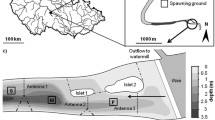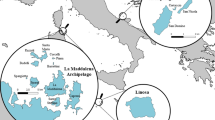Abstract
Mating durations of copepods were found to differ significantly between fishless high-altitude waters and lowland lakes containing fish. In lowland species the whole mating process was completed within a few minutes, but it averaged over an hour in high-altitude species. Alpine copepods showed a prolonged post-copulatory association between mates, during which the male clasped the female for an extended period after spermatophore transfer, while in lowland species males abandoned their partner immediately after copulation. Prolonged associations also occurred after transfer of spermatophores to heterospecific females with shorter conspecific mating duration, suggesting that male interests largely dictate the time spent in tandem. The differences observed may be adaptations to environments with different predation pressure, as pairs in tandem are more conspicuous and less reactive than single animals. We argue that differences in mating behavior and mating duration evolved under sexual versus natural selection, reflecting trade-offs between enhancement of fertilization success and reduction of vulnerability to visual predation. In fishless mountain lakes with high intrasexual competition, guarding males can reduce the risk of spermatophore displacement or the risk that the female will accept sperm from rival males without increased risk of being eaten, thereby maximizing paternity. Populations from fishless alpine lakes further differed from lowland species by exhibiting higher female/male size dimorphism and more intense pigmentation. While these traits vary between populations according to predation pressure, mating duration appears to be more species-specific.




Similar content being viewed by others
References
Anderson RS (1980) Relationship between trout and invertebrate species as predators and the structure of the crustacean and rotiferan plankton in mountain lakes. In: Kerfoot C (ed) Evolution and ecology of zooplankton communities. University Press of New England, Hanover, NH, pp 635–641
Barthelemy RM, Cuoc C, Defaye D, Brunet M (1998) Female genital structures in several families of Centropagoidea (Copepoda: Calanoida). Philos Trans R Soc Lond B Biol Sci 353:721–736
Bateman PW, MacFadyen DN (1999) Mate guarding in the cricket Gryllodes sigillatus: influence of multiple potential partners. Ethology 105:949–957
Bayly IAE (1978) Variation in sexual dimorphism in nonmarine calanoid copepods and its ecological significance. Limnol Oceanogr 23:1224–1228
Berger I, Maier G (2001) The mating and reproductive biology of the freshwater planktonic calanoid copepod Eudiaptomus gracilis. Freshw Biol 46:787–794
Birkhead TR, Johnson SD, Nettleship DN (1985) Extra-pair matings and mate guarding in the common murre Uria aalge. Anim Behav 33:608–619
Blades-Eckelbarger PI (1991) Functional morphology of spermatophores and sperm transfer in calanoid copepods. In: Bauer RT, Martin JW (eds) Crustacean sexual biology. Columbia University Press, New York, pp 246–270
Brooks JL, Dodson SI (1965) Predation, body size, and composition of plankton. Science 150:28–35
Burghard W, Maier G (2000) The effect of temperature on mating duration in the freshwater cyclopoid copepod Cyclops vicinus (Uljanin, 1875). Crustaceana 73:1259–1262
Buskey EJ (1998) Components of mating behavior in planktonic copepods. J Mar Syst 15:13–21
Byron ER (1982) The adaptive significance of calanoid copepod pigmentation: a comparative and experimental analysis. Ecology 63:1871–1886
DeFrenza J, Kirner RJ, Maly EJ, Van Leeuwen HC (1986) The relationships of sex size ratio and season to mating intensity in some calanoid copepods. Limnol Oceanogr 31:491–496
Defaye D, Cuoc C, Brunet M (2000) Genital structures and spermatophore placement in female Paradiaptominae (Copepoda, Calanoida, Diaptomidae). J Crust Biol 20:245–261
Dürbaum J (1995) Discovery of postcopulatory mate guarding in Copepoda Harpacticoida (Crustacea). Mar Biol 123:81–88
Farr JA (1975) The role of predation in the evolution of social behaviour of natural populations of the guppy, Poecilia reticulata (Pisces: Poeciliidae). Evolution 29:151–158
Geddes MC, Cole GA (1981) Variation in sexual size differentiation in North American diaptomids (Copepoda: Calanoida): does variation in the degree of dimorphism have ecological significance? Limnol Oceanogr 26:367–374
Gilbert JJ, Williamson CE (1983) Sexual dimorphism in zooplankton (Copepoda, Cladocera, and Rotifera). Annu Rev Ecol Syst 14:1–33
Grad G, Maly EJ (1988) Sex size ratios and their influence on mating success in a calanoid copepod. Limnol Oceanogr 33:1629–1634
Grad G, Maly EJ (1992) Further observations relating sex size ratios to mating success in calanoid copepods. J Plankton Res 14:903–913
Hairston NG (1976) Photoprotection by carotenoid pigments in the copepod Diaptomus nevadensis. Proc Natl Acad Sci USA 73:971–974
Hairston NG (1979) The adaptive significance of color polymorphism in two species of Diaptomus (Copepoda). Limnol Oceanogr 24:15–37
Hansson LA (2000) Induced pigmentation in zooplankton: A trade-off between threats from predation and ultraviolet radiation. Proc R Soc Lond B 267:2327–2331
Hebert PDN, Emery CJ (1990) The adaptive significance of cuticular pigmentation in Daphnia. Funct Ecol 4:703–710
Hopkins CCE, Machine D (1977) Patterns of spermatophore distribution and placement in Euchaeta norvegica (Copepoda: Calanoida). J Mar Biol Assoc UK 57:113–131
Jacoby CA, Youngbluth MJ (1983) Mating behavior in three species of Pseudodiaptomus (Copepoda: Calanoida). Mar Biol 76:77–86
Jersabek CD, Schabetsberger R (1995) Resting egg production and oviducal cycling in two sympatric species of alpine diaptomids (Copepoda: Calanoida) in relation to temperature and food availability. J Plankton Res 17:2049–2078
Jersabek CD, Brancelj A, Stoch F, Schabetsberger R (2001) Distribution and ecology of copepods in mountainous regions of the Eastern Alps. Hydrobiologia 454:309–324
Johnsen S, Widder EA (2001) Ultraviolet absorption in transparent zooplankton and its implications for depth distribution and visual predation. Mar Biol 138:717–730
Katona SK (1975) Copulation in the copepod Eurytemora affinis (Poppe, 1880). Crustaceana 28:89–95
Kiefer F (1978) Freilebende Copepoda. Schweizerbart’sche Verlagsbuchhandlung, Stuttgart
Knapp RA, Matthews KR, Sarnelle O (2001) Resistance and resilience of alpine lake fauna to fish introductions. Ecol Monogr 71:401–421
Löffler H (1983) Aspects of the history and evolution of Alpine lakes in Austria. Hydrobiologia 100:143–152
Luger MS, Schabetsberger R, Jersabek CD, Goldschmid A (2000) Life cycles, size and reproduction of the two coexisting calanoid copepods Arctodiaptomus alpinus (Imhof, 1885) and Mixodiaptomus laciniatus (Lilljeborg, 1889) in a small high-altitude lake. Arch Hydrobiol 148:161–185
Magnhagen C (1990) Reproduction under predation risk in the sand goby, Pomatoschistus minutus, and the black goby, Gobius niger. Behav Ecol Sociobiol 26:331–335
Magnhagen C (1991) Predation risk as a cost of reproduction. Trends Ecol Evol 6:183–186
Maier G (1996) Variable mating durations in cyclopoid copepods: an adaptation to changing predation risks? Arch Hydrobiol 137:349–361
Maier G, Berger I, Burghard W, Nassal B (2000) Is mating of copepods associated with increased risk of predation? J Plankton Res 22:1977–1987
Maly EJ (1983) Some further observations on diaptomid body size and clutch size relationships. Limnol Oceanogr 28:148–152
Maly EJ, Maly MP (1999) Body size and sexual size dimorphism in calanoid copepods. Hydrobiologia 391:173–179
Mauchline J (1998) The biology of calanoid copepods. Academic, London
Moog O (1979) Zur Populationsökologie des Crustaceenplanktons im Attersee, OÖ. Ph.D. thesis, Universität Wien, Vienna
Ohtsuka S, Huys R (2001) Sexual dimorphism in calanoid copepods: morphology and function. Hydrobiologia 453/454:441–466
Olsson M (1993) Contest success and mate guarding in male sand lizards, Lacerta agilis. Anim Behav 46:408–409
Parker GA (1974) Courtship persistence and female-guarding as male time investment strategies. Behaviour 48:157–184
Rondeau A, Sainte-Marie B (2001) Variable mate-guarding time and sperm allocation by male snow crabs (Chionoecetes opilio) in response to sexual competition, and their impact on the mating success of females. Biol Bull 201:204–217
Rowe L, Arnqvist G, Sih A, Krupa JJ (1994) Sexual conflict and the evolutionary ecology of mating patterns: water striders as a model system. Trends Ecol Evol 9:289–293
Schabetsberger R, Jersabek CD (1995) Alpine newts (Triturus alpestris) as top predators in a high-altitude karst lake: daily food consumption and impact on the copepod Arctodiaptomus alpinus. Freshw Biol 33:47–61
Schabetsberger R, Jersabek CD (2004) Shallow males, deep females: sex-biased differences in habitat distribution of the freshwater calanoid copepod Arctodiaptomus alpinus. Ecography 27:506–520
Schabetsberger R, Grill S, Hauser G, Wukits P (2006) Zooplankton successions in neighboring lakes with contrasting impacts of amphibian and fish predators. Int Rev Hydrobiol 91:197–221
Sherman PW (1989) Mate guarding as paternity insurance in Idaho ground squirrels. Nature 338:418–420
Shuster SM, Wade MJ (2003) Mating systems and strategies. Princeton University Press, Princeton, NJ
Siebeck O, Vail T, Williamson CE, Vetter R, Hessen DO, Zagarese H, Little E, Balseiro E, Modenutti BE, Seva J, Shumate A (1994) Impact of UV-B radiation on zooplankton and fish in pelagic freshwater ecosystems. Arch Hydrobiol Beih Ergebn Limnol 43:101–114
Sih A, Krupa J, Travers S (1990) An experimental study of the effects of predation risk and feeding regime on the mating behavior of the water strider. Am Nat 135:284–290
Simmons LW (2001) Sperm competition and its evolutionary consequences in the insects. Princeton University Press, Princeton, NJ
Starkweather PL (1990) Zooplankton community structure of high elevation lakes: biogeographic and predator–prey interactions. Verh Internat Verein Limnol 24:513–517
Svensson JE (1995) Predation risk increases with clutch size in a copepod. Funct Ecol 9:774–777
Thornhill R, Alcock J (1983) The evolution of insect mating systems. Harvard University Press, Cambridge, MA
Tsuda A, Miller CB (1998) Mate-finding behaviour in Calanus marshallae Frost. Philos Trans R Soc Lond B Biol Sci 353:713–720
Van Leeuwen HC, Maly EJ (1991) Changes in swimming behavior of male Diaptomus leptopus (Copepoda: Calanoida) in response to gravid females. Limnol Oceanogr 36:1188–1195
Watras CJ (1983a) Mate location by diaptomid copepods. J Plankton Res 5:417–423
Watras CJ (1983b) Reproductive cycles in diaptomid copepods: effects of temperature, photocycle, and species on reproductive potential. Can J Fish Aquat Sci 40:1607–1613
Watras CJ, Haney JF (1980) Oscillations in the reproductive condition of Diaptomus leptopus (Copepoda: Calanoida) and their relation to rates of egg-clutch production. Oecologia 45:94–103
Williamson CE, Butler NM (1987) Temperature, food and mate limitation of copepod reproductive rates: separating the effects of multiple hypotheses. J Plankton Res 9:821–836
Wolf E (1905) Die Fortpflanzungsverhältnisse unserer einheimischen Copepoden. Zool Jb Abt Syst 22:101–280
Ylönen H (1994) Vole cycles and antipredatory behaviour. Trends Ecol Evol 9:426–430
Zellmer ID (1995) UV-B-tolerance of alpine and arctic Daphnia. Hydrobiologia 307:153–159
Acknowledgments
Financial support for my (C.D.J.) research stay in Milwaukee, WI, was provided by the “Stiftungs- und Förderungsgesellschaft, Universität Salzburg”. We are grateful to Alex De Robertis and two anonymous reviewers for critically reading and improving the manuscript.
Author information
Authors and Affiliations
Corresponding author
Additional information
Communicated by Ulrich Sommer.
Rights and permissions
About this article
Cite this article
Jersabek, C.D., Luger, M.S., Schabetsberger, R. et al. Hang on or run? Copepod mating versus predation risk in contrasting environments. Oecologia 153, 761–773 (2007). https://doi.org/10.1007/s00442-007-0768-1
Received:
Accepted:
Published:
Issue Date:
DOI: https://doi.org/10.1007/s00442-007-0768-1




